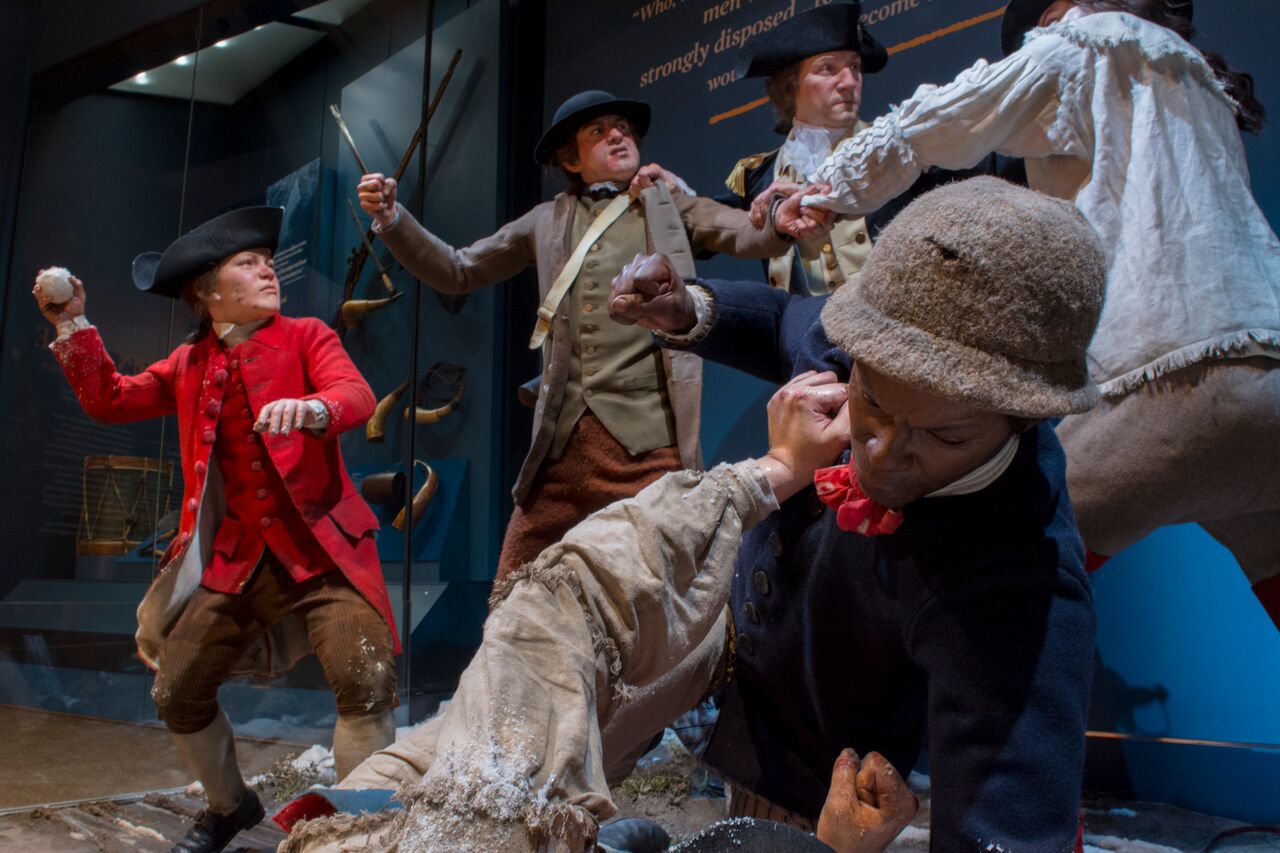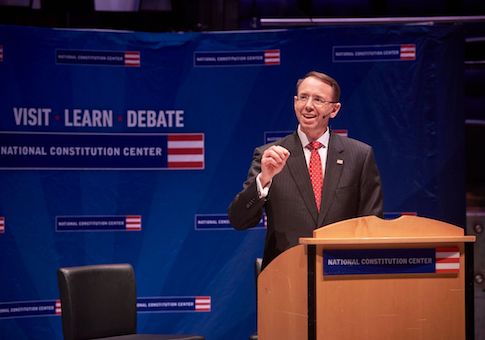PHILADELPHIA—Nobody, as far as I know, gets off from work to observe Constitution Day. It's yet to be honored with a "doodle" from Google, which both this year and the last marked Constitution Day with separate graphics honoring Honduran Teachers' Day.
The only place Constitution Day gets the respect it deserves is at the National Constitution Center, where president Jeffrey Rosen described the holiday as "the most exciting day of the year." It is also the site where deputy attorney general Rod Rosenstein delivered his first Constitution Day address.
I spent the hours leading up to the Monday night address with Rosenstein discussing his views on where the Constitution stands today.
He pointed me to a passage in an 1838 Abraham Lincoln speech to a group of young men in Illinois on the perpetuation of our political institutions. Lincoln calls for every American to "pledge his life, his property, and his sacred honor" to the Constitution and the rule of law. Lincoln calls for "reverence for the laws" to be "breathed by every American mother to the lisping babe that prattles on her lap." He wants the Constitution to be "written in primers, spelling book, and in Almanacs," and "preached from the pulpit." He hopes that the Constitution becomes the "political religion of the nation," and that people of all stripes in the nation are willing to "sacrifice unceasingly upon its altars."
That’s not quite where we are today. Last week, Hillary Clinton bitterly argued that the Electoral College, one of the founders' chief compromises on representation, "needs to be eliminated."
Rosenstein, however, is on Team Lincoln.
"Lincoln recognized that you had to keep talking about the Constitution to keep it alive in the hearts of the public, and not just have people thinking they're dry words on paper," he explained. The goal of his speech was to "remind people how novel the American experiment is."
"Americans today really take it for granted," he said. "We're so far removed from the Revolution and the Constitution, people just presume that they're going to have freedom, liberty, and democracy."
In the hours leading up to his speech, we went through a crash-course on the Constitution's history.
We started our trip at the Museum of the American Revolution, a project that has been in the works for more than a century but that just opened earlier this year. The museum’s goal is to tell the stories of the founding era through its vast collections of artifacts.

The artifact serving as its "crown jewel" is George Washington's war tent, a small 16' by 23' space that served as both his office and bedroom. It's story, however, is less about the harrowing Revolution, and more about how it still survives two centuries later.
Washington's tent was eventually passed down to his step-grandson's daughter, Mary Custis Lee, who was the wife of General Robert E. Lee. When their home was occupied by Union troops during the Civil War, the tent was seized and put under government control. In the early 1900s, it was returned to the Lee family, who quickly put it up for sale. The buyer, a Pennsylvania minister, collected money from hundreds of Americans to purchase the tent in 1909 for $5,000 with hopes of making it the centerpiece of a museum. In the years preceding the opening of the museum, a team of engineers and conservationists worked to figure out how to re-erect the tent and ensure that the 239-year-old fabrics will survive for generations.
The fragile tent's long journey through hardship is a symbol that drives the museum, according to our historian guide.
"The tent, like the Republic, survives," he said after we watched a video presentation about the tent. "It remains a symbol of the fragile American experiment, the power of the people to secure their own freedoms."
"Maintaining the tent and maintaining the Constitution both take a lot of attention, and they only stand erect with an active citizenry."
We then toured the rest of the museum, which goes above and beyond Rosenstein's hopes that history will be kept "alive." Each room is filled with wax people, often sitting atop freakishly life-like stuffed horses. Rooms are filled with sounds of war and brawls in the street. The goal is to immerse you in the period. It's a mixed success. As the Weekly Standard's Andrew Ferguson noted earlier this year, the museum's desire to wow children with dramatic stages has a tendency to dumb down the history to something that barely resembles history.
But the message still gets across.
"These historical locations are a reminder that people had to fight and die for liberty," Rosenstein said after we left. "A lot of kids learn something about the founding era, but I’m not sure it really sinks in."
The real education comes on our next stop. The National Constitution Center, chartered by Congress "to increase the awareness and understanding of the Constitution among the American people," waives its usual fees on Constitution Day. More than 3,000 middle school students visited the center on Monday alone.

We were first brought into a theatre and treated to "Freedom Rising," a live theatrical re-telling of the story of the Constitution. Then Rosen, the center's president, took us through its collection of original drafts of the document, tracing the evolution of the preamble and each of its clauses. It's not until September 12, just five days prior to the signing, that the phrase "We the People" makes it into the Constitution for the first time.
An interactive screen at the museum, which is available both online and on a phone app I now have, allows you to trace exactly how each amendment in the Bill of Rights evolved. Also available is a tool that shows what countries across the globe have similar rights to the ones laid out in our Constitution. The United Kingdom, for example, has something similar to our Second Amendment, except it guarantees the right to have arms only for "subjects which are Protestants." In Iran, the right is exclusively for "striking fear into God's enemy."
Rosenstein then prepared to deliver his speech to a crowd of hundreds gathered in the theatre we sat in earlier. The theme of his speech was that constitutional freedoms should never be taken for granted, because they are all reliant on our acceptance of the rule of law.
"The words written in the Constitution by Benjamin Franklin and his contemporaries protect our liberty, so long as we adhere to the rule of law," Rosenstein said. "The rule of law is not just a feature of America. The rule of law is the foundation of America."
"The rule of law is not self-executing," he said. "If it collapses—if the people lose faith in the rule of law—then everyone will suffer."

He elaborated before his speech.
"The rule of law states that we apply the laws as they were written," he told me. "What's inconsistent with the rule of law is to say, 'We don't like this, so even though this is the result dictated by the law, we're going to do something else.’"
"These are the rules, they were adopted for a reason," he went on. "You can agree or disagree on the reason, but we all agree on what the rules are. That debate ought to be held in a political forum, and be resolved politically—not by executive fiat, not by judicial fiat, but by changing the law."
"That's the whole point of this process, that we have a deliberative legislative body that can change the law if enough people decide that they don't like it."
The speech was received well, though most of the questions that followed from the crowd moved the conversation away from the Constitution and towards Russia. Rosenstein handled them with a smile on his face.
Leaving the center, my Uber driver asked me what the big crowd was for. I told him that it was because there was an event there for Constitution Day. The driver quizzically asked why, pointing out, both surprisingly and correctly, that Constitution Day had been the day before.
I guess his knowledge of American holidays is based on more than Google doodles.
